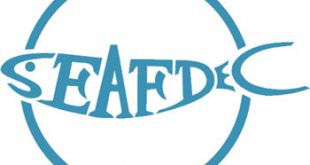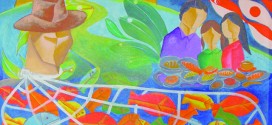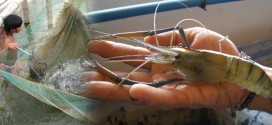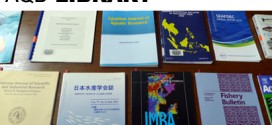SEAFDEC/AQD teams up with the village resource management council of Molocaboc in Sagay, Negros Island, Philippines for a new project on the culture of abalone (Haliotis asinina) and seaweed (Gracilaria). AQD was also on hand at the launching of 12 marine sanctuaries in San Joaquin, Iloilo, Philippines on 16 August 2011 where AQD and LGU-San Joaquin collaborate on studies on giant clam and coral growth vis-à-vis climate change.
Read More »Rossea H. Ledesma
Red tilapia & siganid for sale
SEAFDEC/AQD is set to harvest red tilapia and siganids from its Dumangas Brackishwater Station in Iloilo on 23 August. The red tilapia will be sold at Php 85-100 per kg for sizes 300 gm and above; while siganids will be priced at Php 80-115 per kg for sizes 100 gm and above. For orders and inquiries, you may contact AQD’s Materials Control Unit at (033) 511-8091 or (033)511-9171 loc 320.
Read More »Tilapia hatchery
Technology Description Tilapia has been dubbed the “aquatic chicken” because it grows fast, breeds in captivity easily, and the technology for its propagation and culture requires little input. Hatcheries can readily supply the seedstock that the tilapia farming industry needs. Hatcheries are of three types: concrete tanks, which give the highest production; hapa netcages in lakes, the second highest; then ponds. Technology profile: (1) Get good breeders (50-250 g) from reputable hatcheries; or, raise them from the fry stage until they mature in 3 months. For the latter, breeding trials at SEAFDEC/AQD have shown that tilapia farmers can select healthy broodstocks from within the normal or average size range distribution; this means not selecting the largest fish. (2) For concrete …
Read More »Marine cage culture of grouper
Technology Description The technology of cage culture is relatively cheap and easy to run. The materials used in construction are indigenous and readily available like the bamboo supports. Filipinos are used to working with bamboo. In addition, grouper fry can now be produced in hatcheries or transported from areas where fry collection is an established industry, and there are a lot of places in the country where this is so. Marine cage culture of grouper can be done in 4- to 12-compartment cage as one unit. There are nursery (small mesh is used in the cage) and grow-out phases (larger mesh). Grouper need to be sorted and size-graded every week. Other routine procedures include feeding (trash fish and/or formulated feeds), …
Read More »Marine pond culture of grouper
Technology Description Grouper is a high-value species like tiger shrimp, and with prudent pond management, it is easier to culture without the attendant disease problems with prudent pond management. Shrimp farmers seeking alternative crops have found one in grouper. Preparing the ponds for grouper is similar to milkfish and shrimp pond preparation. In addition, grouper fry or “tiny” need to be nursed first and must be regularly sorted and size-graded. Rectangular netcages supported by bamboo poles and installed inside the pond can serve as nursery. A hover-type lamp can attract live food for the grouper fry. Nursery takes about a month. At the same time that grouper fry is stocked in the nursery, adult tilapia are released into grouper grow-out …
Read More »Milkfish hatchery
Technology Description It might be expensive to integrate broodstock with hatchery; hence, hatchery operators may opt to buy milkfish eggs from broodstock operators like SEAFDEC/AQD. This distinction between egg suppliers and fry suppliers is what make Taiwan’s milkfish industry very successful because the risks are spread among sectors of the industry. Filipino entrepreneurs are enjoined to do the same. Eggs are hatched, raised, and then sold at day 21 or older. Natural food (Chlorella, Brachionus, Artemia) are fed to the larvae, enriching the rotifer and Artemia in particular with highly unsaturated fatty acids (HUFA) and Vitamin C. The SEAFDEC/AQD-formulated larval feed may be given in combination with natural food from day 3-5 until harvest. Water change, cleaning tanks, frequent monitoring …
Read More »Seabass grow-out culture
Technology Description Brief description: Seabass is a species that is easy to culture in cages or in brackishwater ponds. It is hardy, and the seedstock can be easily sourced from the hatchery. There is a need, however, to include a nursery before the grow-out phase so that seabass can be easily sorted and size-graded to reduce competition for space and food, thus controlling cannibalism. Survival in the 30-45 day nursery phase can be as high as 96%. The biggest expense for seabass culture is feeds, as the fish is carnivorous and must be fed trash fish. But there are already available high-protein formulated feeds that can be used like SEAFDEC/AQD’s formulation for carnivorous species. And, other than the regular sorting …
Read More »Seabass hatchery
Technology Description Brief description: Seabass can easily be spawned using a hormone and its larvae reared in the hatchery with 90% survival. The only potential problem for the hatchery operator is that seabass are protandrous hermaphrodites, that is, they first mature as males then become females on their sixth year or when they are over 3 kg in size. Should egg production decrease as a result of having more female broodstock, the operator must cull and acquire younger or male broodstock. Wild spawners may be used, or breeders raised in cages,tanks or ponds. Seabass are injected with LHRHa, and left to spawn for 2-3 consecutive days. The larvae that hatched from the eggs are fed mostly live food, Brachionus and …
Read More »Kappaphycus (seaweeds) farming
Technology Description The farming of the seaweed Kappaphycus can be a low-cost venture and a profitable one, with the right site. The technology can use family labor in either fixed off-bottom (“parasdas”) or single raft long-line culture. The more line modules, the more investment and care are needed. After tying seaweed plantlets or “seedlings” to the ropes, and the ropes staked to the sea bed by bamboo or tied to floating rafts staked to the sea bed, seaweed farming needs no more inputs. There is periodic visitation, two to three times a week, to remove undesirable algae, barnacles, and attached sediments; to re-tie loose or fallen seaweed; to tighten lines; and to check for signs of “ice-ice” disease. Seaweed culture …
Read More »Brackishwater pond culture of black tiger shrimp
Technology Description Brief description: This new technology on shrimp farming in brackishwater ponds incorporates pollution management which constitutes 9% of annual shrimp production cost per ha of the farmer. Pollution management is worth the cost considering that a shrimp farmer could lose it all during a disease outbreak. Environment-friendly practices include: (1) Lowered stocking density ~ this may decrease harvest volume by 20-30% but the harvest value could increase by 8-10%due to bigger size and improved feed conversion. Feeding and nutrient loading is reduced by 20%, and the risk of opportunistic diseases is reduced as well. (2) Improvement of pond bottom management ~ this may increase plowing or tilling cost, add netcage construction to the expense but these costs could …
Read More »Hatchery of penaeid shrimps
Technology Description Brief description: Hatcheries are indispensable to grow-out operators especially when seedstock supply from the wild is not assured. For tiger shrimp, the technology can be relatively low-cost “backyard type” very popular among aquaculturists in the 1980s, or medium to large scale With fewer shrimp hatcheries continuing operations up to the present, the market potential is big. (Marketing is one of the problems of shrimp hatcheries. Since fewer ponds are stocked with shrimp due to disease threats/occurrence, demand for shrimp fry has also decreased). To put-up a hatchery, an entrepreneur needs to decide on target production. For every million of postlarvae (day 15-20), a total tank volume of 80-100 tons is required. This is based on these assumptions: (1) …
Read More »Artwork by Filipino schoolchildren (103 drawings, 2011)
Their take on fisheries for food security - adaptation to the changing environment
Read More »Freshwater prawn training, enroll now!
On 22 August, the 5-day course on Freshwater prawn hatchery and grow-out will start. Venue is AQD’s Binangonan Freshwater Station in Rizal, Philippines; training fee, Php 6000 or USD 500 per person. Email mreguia@seafdec.org.ph
Read More »2011 releases – The rise of SaaS in achieving operational excellence
SaaS has increasingly become an everyday part of how business is done across the globe; according to Statista, the global SaaS market is forecast to reach 157 billion US dollars in size by 2020, more than doubling 2014 figures. This enormous growth reflects the extent to which SaaS is empowering organizations to do business better, helping businesses to achieve always-on flexibility, agility and scalability, increasing ROI on IT spend while freeing up valuable resources to focus on long-term strategy. Software-as-a-Service (SaaS) refers to software which is owned, delivered and managed remotely; rather than purchasing software packages, organizations pay for their usage of a cloud-based package, whether on a pay-for-use or subscription model. This has proven very appealing to the market; …
Read More »Researchers in action
Show-and-tell of their work, and presenting the results in a mid-year 2011 review
Read More »LIBRARY
Crab fattening in cages/pen culture of crabs in mangroves
Technology description To produce food through aquaculture without sacrificing the environment is an apt description for the culture or fattening of mudcrab in mangrove areas. The use of net enclosures in mangroves or tidal zones offers a better alternative to pond culture. It also promotes a better image for brackishwater aquaculture that had been linked to the historical clear-cutting of mangroves to make way to ponds. For fattening, the technology involves the construct of small cages with individual cells which are then stocked with lean crabs, weighing at least 100 g (if female native crabs) or 300 g (if female giant crab). Males weighing 200 g (if native) or 350 g (giant crab) may also be stocked individually in the …
Read More »Hatchery & nursery of mud crab
Technology description Although the technology applies to all three species of mud crab (Scylla serrata, S. tranquebarica, S. olivacea), S. serrata or giant/king crab has been the focus of culture due to its economic viability. Healthy mature crabs with complete limbs are chosen as breeders. The crabs are maintained in the tank until they spawn (release of eggs). After hatching of eggs, care is taken to raise the zoea to the megalopa stage in the hatchery. Feed used are Brachionus and Artemia. Water replacement may be from 30 to 80% every 5 days. Megalopae are then transferred to nursery tanks or net cages before they can be stocked in ponds or pens, and are fed mollusks or fish. Hatchery and …
Read More »Virus expected to cost Australian abalone industry
Virus expected to cost Australian abalone industry A herpes-like virus in wild and farmed abalone stocks are wreaking havoc, which could cost the abalone industry in south-west Victoria in Australia up to $5 million in losses this season. The virus responsible for ganglioneuritis, as reported here, is believed to have come from an aquaculture facility in Portland, moving east. Ganglioneuritis causes inflammation of abalone nervous tissue, resulting in curling of the foot and swelling of the mouth. Stakeholders are not very optimistic in their outlook about the situation; divers, such as Peter Riddle, are angry at the State Government’s handling. He thought that it is “too late” to do anything now, “the disease is in the ocean and I don’t …
Read More »Abalone: don’t cramp my style
Abalone: don’t cramp my style Cramped spaces leave abalones with little room for attachment and feeding Abalone farming is a growing aquaculture industry. New frontiers are being explored to expand the production of this valuable commodity, which has various researchers testing the waters in terms of culturing the tropical abalone Haliotis asinina in sea cages. Since studies have shown that stocking density has an inverse relationship with the growth of abalone, the trick is to find a middle ground wherein a given area could still be able to support the growth of abalone. This begs the question: Does the shelter surface area (SSA) of mesh cages have an effect on the feeding, growth and survival of the tropical abalone? …
Read More » SEAFDEC/AQD Southeast Asian Fisheries Development Center | Aquaculture Department
SEAFDEC/AQD Southeast Asian Fisheries Development Center | Aquaculture Department



